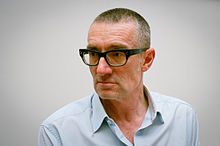Thomas Hirschhorn
Thomas Hirschhorn (born May 16, 1957 in Bern ) is a Swiss installation artist .
life and work
Thomas Hirschhorn has lived and worked in Paris , France , since 1984 . Born in Bern, Thomas Hirschhorn grew up in Davos , attended the University of Art and Design in Zurich and gained international recognition for his installations from the mid-1990s, for example the installation Kunsthalle prekär in Langenhagen (1996). According to his own statement, Hirschhorn sees himself as an artist who «makes art political».
Hirschhorn achieved greater international fame with the installation “Swiss-Swiss Democracy” in the Swiss cultural center in Paris in 2004. According to media reports , this was a scandal because it harmed the country's external image. After a wave of outrage in the National Council , as a punitive action by the Pro Helvetia cultural foundation, the funds in the amount of the foundation's contribution to this exhibition were cut. The stumbling block was, among other things, an attack on Federal Councilor Christoph Blocher or the collage of images of torture from Iraq with the coats of arms of the Swiss cantons; a detail in the sculptural installation typical of Hirschhorn.
Another type of installation that Hirschhorn sets up in public places in various cities is the street altar . So far he has dedicated his altars to four writers and artists: Piet Mondrian , Otto Freundlich , Raymond Carver and Ingeborg Bachmann . In October 2006 he installed the “Ingeborg Bachmann Altar” in the Berlin Alexanderplatz subway station for the exhibition project “U2 Alexanderplatz” of the New Society for Fine Arts (NGBK) .
Crystal of Resistance was the title of Thomas Hirschhorn's installation in the Swiss Pavilion at the 54th Venice Biennale . With this work Hirschhorn wanted to ask three questions about his work. "First: Can my work create a new concept of art? Second: Can my work build a 'critical body'? Third: Can my work imply a 'non-exclusive audience'?" For ten weeks in the summer of 2013 in New York City, his Gramsci Monument pavilion opened to residents and international guests in the Bronx .
Thomas Hirschhorn is represented by the Arndt Gallery in Berlin.
literature
- Thomas Hirschhorn, Marcus Steinweg : MAPS. Merve, Berlin 2008, ISBN 978-3-88396-253-5 (German) / ISBN 978-3-88396-254-2 (English)
- Fabian Stech : J'ai parlé avec Lavier, Annette Messager, Sylvie Fleury, Hirschhorn, Pierre Huyghe, Delvoye, DG-F., Hou Hanru, Sophie Calle, Ming, Sans et Bourriaud. Les presses du réel, Dijon 2007, ISBN 2-84066-166-7
Awards (selection)
- 2001: Prize for Young Swiss Art
- 2001: Prix Marcel Duchamp
- 2003: Roland Prize for Art in Public Space
- 2004: Joseph Beuys Prize Basel
- 2011: Kurt Schwitters Prize , Hanover
- 2018: Prix Meret Oppenheim
Exhibitions (selection)
- 1994: Jeu de Paume , Paris.
- 1998: "Swiss Army Knife", Kunsthalle Bern .
- 2001: Kunsthaus Zurich , Zurich.
- 2002: Documenta11 , Kassel , here the Bataille Monument , which he showed from May to September in the Friedrich-Wöhler-Siedlung.
- 2003: United Nations Miniature, Málaga Contemporary Art Center
- 2004: 24h Foucault, Palais de Tokyo , Paris.
- 2004: Center Culturel Suisse , Paris.
- 2005: Pinakothek der Moderne , Munich .
- 2005: Bonnefantenmuseum , Maastricht .
- 2006: Kestnergesellschaft , Hanover.
- 2008: Vienna Secession Building , Vienna .
- 2010: Intensif-Station, K21 Ständehaus .
- 2011: Swiss Pavilion at the 54th Venice Biennale , Title: Chrystal of Resistance .
- 2013: Gramsci Monument Pavilion in New York City, Bronx.
- 2016: SPERR , Wiesbaden Biennale, Wiesbaden State Theater .
- 2018: Never give up the spot , Villa Stuck , Munich.
- 2019: Robert Walser sculpture, Biel .
Public collections
- Falckenberg Collection , Hamburg
- Kunsthalle Mannheim
- K21 Ständehaus , Düsseldorf
Web links
- Literature by and about Thomas Hirschhorn in the catalog of the German National Library
- Works by and about Thomas Hirschhorn in the German Digital Library
- Materials by and about Thomas Hirschhorn in the documenta archive
- Thomas Hirschhorn in the ifa database
- Regula Freuler: Hirschhorn, Thomas. In: Sikart (status: 2014)
- Installation in Berlin Alexanderplatz subway station
- Conversation with Thomas Hirschhorn in the NZZ Folio magazine
- Thomas Hirschhorn - Exhibition "The Eye" in the Vienna Secession (CastYourArt video podcast)
Individual evidence
- ↑ Pro Helvetia distances itself from the attack on Christoph Blocher . In: Neue Zürcher Zeitung from December 6, 2014
- ↑ Quoted from 'Crystal of Resistance', Thomas Hirschhorn; Information sheet of the Swiss Pavilion, Venice June 1 to November 27, 2011. (No longer available online.) Archived from the original on November 9, 2014 ; Retrieved November 9, 2014 . Info: The archive link was inserted automatically and has not yet been checked. Please check the original and archive link according to the instructions and then remove this notice.
- ↑ Hot dogs at the Gramsci bar - the artist Thomas Hirschhorn has set up a culture pavilion in New York , Deutschlandradio Kultur from July 9, 2013, accessed July 10, 2013
- ^ Prix Meret Oppenheim 2018. In: www.bak.admin.ch. Federal Office of Culture , accessed on November 1, 2019 .
- ↑ On the holey reality. In: Frankfurter Allgemeine Sonntagszeitung from May 15, 2016, p. R5
- ↑ Close your eyes and get on with it . In: Neue Zürcher Zeitung of March 7, 2019
| personal data | |
|---|---|
| SURNAME | Hirschhorn, Thomas |
| BRIEF DESCRIPTION | Swiss artist |
| DATE OF BIRTH | May 16, 1957 |
| PLACE OF BIRTH | Bern |


